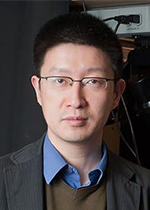
Events

Events
Title:Advancing Acoustic Application with Architectured Metamaterials
Time:15:00-16:30, Aug.15,2019
Place:F210, School of Mechanical Engineering
Host:GU Guoying, Professor (Institute of Robotics)
Biography
Nicholas X. Fang received his BS and MS in physics from Nanjing University, and his PhD in mechanical engineering from University of California Los Angeles. He arrived at MIT in Jan 2011 as Associate Professor of Mechanical Engineering. Prior to MIT, he worked as an assistant professor at the University of Illinois Urbana-Champaign. Professor Fang's areas of research look at nanophotonics and nanofabrication. His recognitions include the ASME Chao and Trigger Young Manufacturing Engineer Award (2013); the ICO prize from the International Commission of Optics (2011); an invited participant of the Frontiers of Engineering Conference by National Academies in 2010; the NSF CAREER Award (2009) and MIT Technology Review Magazine's 35 Young Innovators Award (2008).
Abstract
Today, sound is an indispensable component in numerous industrial and consumer products, such as musical instruments, cars, building technology, medical diagnostics, and many others. Acoustic characteristics are among their most important properties, greatly influencing their function and our society at large. Recent development of acoustic metamaterials opens a door to an unprecedented large design space for acoustic properties such as negative bulk modulus, negative density, and refractive index. These novel concept expands paves the way for the design of a new class of acoustic materials and devices with great promise for diverse applications, such as broadband noise insulation, sub-wavelength imaging and acoustic cloak from sonar detection.
In this invited talk, I will present our development of advanced design and micro/nanofabrication techniques, to enable exploration architectured meta structures for acoustic waves. These structures show promise on focusing and rerouting ultrasound through broadband metamaterials. As example, our study on the sound absorption of thin composite aerogel foams using a bimodal porous structure predicts a possible route to perfect thin film absorber by increasing the amount of epoxy resin. In a second case, stimuli‐responsive acoustic metamaterials are demonstrated to be able to extend the 2D phase space to 3D through rapidly and repeatedly switching signs of constitutive parameters with remote magnetic fields. Lastly I will report our study on a prototype hydraulic hydrogel actuators with excellent optical and sonic transparency.


Shanghai Jiao Tong University
Address: 800 Dongchuan Road, Shanghai
200240